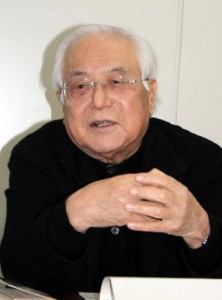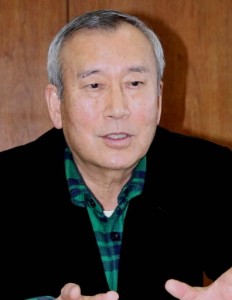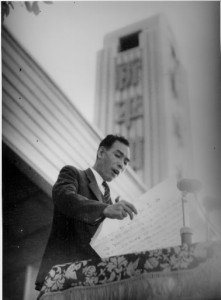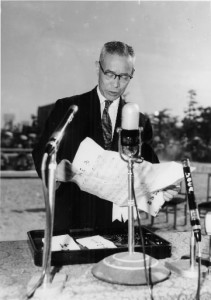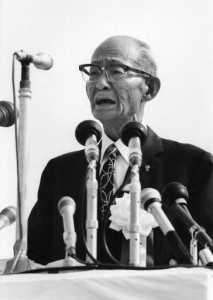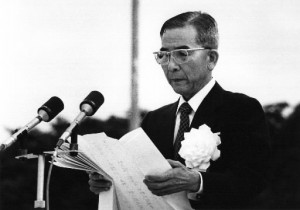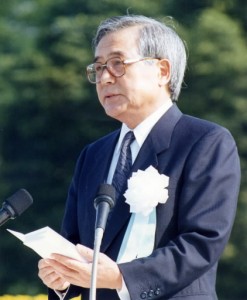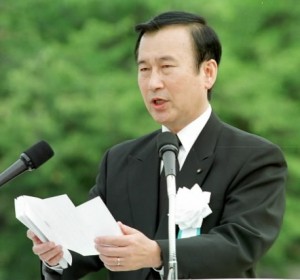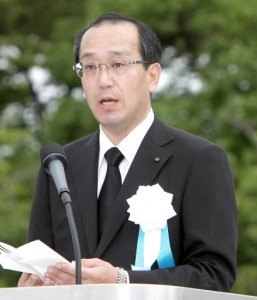Peace Seeds: Teens in Hiroshima Sow Seeds of Peace (Part 4)
Mar. 16, 2015
Part 4: Peace Declarations convey desire and determination for nuclear abolition
On August 6, 1947, two years after the atomic bombing of Hiroshima, then Hiroshima Mayor Shinso Hamai read the first Peace Declaration at the city’s first Peace Festival. Since that time, each mayor of Hiroshima has read aloud a peace declaration on the anniversary of the atomic bombing. The only exceptions were in 1950, when the ceremony was canceled, and in 1951, when the mayor at that time delivered a “speech.”
Hiroshima has been appealing for the abolition of nuclear weapons, calling them “an absolute evil” that will bring the human race to ruin. However, it is estimated that nine nations, including the United States and Russia, still possess more than 16,000 nuclear warheads, according to a report issued by the Stockholm International Peace Research Institute in January 2014. Also, the fact that Japan is protected by the U.S. nuclear umbrella is unsettling because a peace protected by nuclear arms is not a genuine peace.
Seventy years have passed since the atomic attack. With the survivors aging, we are faced with the urgent task of handing down their experiences. The junior writers have been listening to the survivors’ accounts and conveying their messages. But we hope that a greater number of people will show interest in this issue.
With this desire in mind, we have written our own Peace Declaration after conducting interviews with two former Hiroshima mayors.
Peace Declaration by the Junior Writers
Desire and determination for nuclear abolition
Still 16,000 nuclear warheads in nine countries
Is Japan really peaceful under the nuclear umbrella?
Fewer survivors 70 years after the bombing
Taking these current circumstances into consideration, we have drafted our Peace Declaration.
● Citizens of the world, look at Hiroshima. Come to know Hiroshima.
We hope people at home and abroad will show more interest in Hiroshima. Come visit Hiroshima. In order not to repeat the same catastrophe that occurred 70 years ago, it is vital that more people come to understand the inhumane nature of nuclear weapons and convey this to other people. Toward this end, we will hold more atomic bomb exhibitions and consider ideas like holding international film festivals or music festivals on the theme of war and peace or holding exchange programs where young people make presentations about the history of their countries.
● Politicians of the world, especially the leaders of nuclear weapon states and would-be nuclear states, come to Hiroshima and sincerely commit yourselves to nuclear abolition.
We do not need nuclear weapons. Why do adults not realize this? Such weapons put lives at risk and impose huge economic burdens on a nation’s finances. And there is always the danger of an accident or a terrorist group getting their hands on these weapons. It would be much better if the money being spent on nuclear arms was used to fight poverty in the world. Come to Hiroshima and learn the reality of nuclear weapons. We will serve as your guides.
● Leaders of Japan, lead the world.
The international community respects that, following World War II, Japan has supported a Constitution which renounces war. It is time to remove this nation from the nuclear umbrella and call on the United States to eliminate it entirely. Mayors for Peace has been pursuing a campaign to abolish nuclear weapons by the year 2020. There are five years left. As the only A-bombed nation, Japan should lead the world with confidence.
● People around the world, strengthen dialogue with one other.
A wide variety of people live on this earth. Let us learn about other people’s values. In order to understand our differences, we should engage in more dialogue. We believe this will help eliminate the root causes of conflict.
● We, the junior writers, will continue learning about and conveying the preciousness of peace.
There is only a limited amount of time to listen directly to the A-bomb survivors. Many people are making efforts to hand down the survivors’ experiences and wishes to the next generation. The junior writers will join their efforts by writing articles and sharing them with the world.
(Edited by Harumi Okada, 15)
Interviews with former mayors of Hiroshima
On August 6, at the annual Peace Memorial Ceremony, the mayor of Hiroshima reads aloud the Peace Declaration. The junior writers interviewed two former mayors, who read declarations on the milestone years of 1995 and 2005.
Takashi Hiraoka, 87, read peace declarations between 1991 and 1998
Suffering and inflicting suffering, both perspectives
How did you draft your peace declarations?
There were two pillars to my declarations: “abolishing nuclear weapons and pursuing world peace” and “consoling the spirits of the victims and strengthening support for the survivors.” I also included the attitude that Hiroshima should adopt based on the global and domestic conditions each year. These declarations become records. And if such records are kept every year, they become part of history. As I was writing the declarations, I held the hope that these records would help convey memories of the past to future generations.
In 1991, 1992, 1993, and in 1995, the 50th anniversary of the atomic bombing, you included an apology for the people of Asia.
Because of the atomic bombing, Hiroshima experienced immense suffering. On the other hand, Japan’s activities back then made people in Asia suffer. We must consider both aspects. After deep deliberation, I decided what Hiroshima should say to people in Asia.
What does “peace” mean to you?
Just eliminating nuclear weapons will not make peace. We must eliminate poverty, disease, and human rights violations. I believe creating conditions in which everyone can live in contentment is the way to build a peaceful world.
What would you like younger generations to do?
Don’t bully. Don’t litter. It is important to continue doing what you can do in your daily lives. Through these efforts, it’s possible to have an impact on politics. Learn history and listen to the views of many people. Embrace a vision and create a future that can be passed on to the next generation.
(Interviewed by Aoi Nakagawa, 14 and Shiho Fujii, 13)
Tadatoshi Akiba, 72, read peace declarations between 1999 and 2010
Urging cities around the world to stand united
What is a Peace Declaration? How did you develop the ideas for your declarations?
A peace declaration is the most important message Hiroshima delivers to the world. I spent a whole year communicating with citizens and survivors and listened to voices from around the world to draw up my declaration. I incorporated mourning for the victims and my vision for the future.
What were you attentive to?
I expressed my gratitude to the survivors, who faced death but chose to live and strived to reconstruct the city. I tried to convey the survivors’ message that no one else should be made to endure the same hardships. It is partly because the survivors have continued to communicate their wish to the world that a third A-bombed city has not been created during the past 70 years.
In 2005, for your Peace Declaration on the 60th anniversary of the bombing, you said, “It is a time of inheritance, of awakening, and commitment,” and you urged cities and people around the world to take action.
As Mayors for Peace has expanded, cities around the world have become more closely united, and ordinary citizens have a stronger voice. During wartime, cities become the targets. If all citizens raise their voices for the preciousness of life, and these voices are joined together, this would create immense power. When a city joins Mayors for Peace, this is equivalent to taking action for the abolition of nuclear weapons.
What are your hopes and advice for the younger generation?
In order not to repeat the mistakes of the past, young people should learn about World War II and the A-bomb experiences and make use of this knowledge. In this way, you will be able to learn lessons for shaping the future.
(Interviewed by Kantaro Matsuo, 16 and Nanaho Yamamoto, 15)
Major incidents related to Hiroshima and the annual Peace Declarations
1945: Atomic bombs are dropped on Hiroshima and Nagasaki. World War II ends.
1947: The first Hiroshima Peace Festival is held. The first Peace Declaration is delivered.
1949: The Hiroshima Peace Memorial City Construction Act goes into effect.
1952: The Hiroshima Peace Memorial Ceremony is held in front of the Cenotaph for the A-bomb Victims in Peace Memorial Park from this year on.
1954: Crew members of the Daigo Fukuryu Maru (The Lucky Dragon No. 5), a Japanese tuna fishing boat, are exposed to radioactive fallout from a U.S. hydrogen bomb test.
1970: The Nuclear Non-proliferation Treaty (NPT) goes into effect.
1982: The World Conference of Mayors for Peace through Intercity Solidarity (now, Mayors for Peace) is established in response to a proposal from the mayors of Hiroshima and Nagasaki.
1986: An accident occurs at the Chernobyl nuclear power plant.
1989: The International Physicians for the Prevention of Nuclear War (IPPNW) holds an world conference in Hiroshima. The end of the Cold War is declared by heads of the United States and Russia.
1994: The Asian Games are held in Hiroshima.
1995: The Atomic Bomb Survivors Relief Law comes into force.
1996: The International Court of Justice (ICJ) issues an advisory opinion that the threat or use of nuclear weapons would generally be contrary to the rules of international law. The A-bomb Dome is added to the UNESCO World Heritage list.
1999: The Peace Declaration is written in a more colloquial and polite style starting this year.
2000: The NPT review conference adopts the final document which stipulates that the elimination of nuclear weapons is an "unequivocal undertaking."
2003: Mayors for Peace announces its 2020 Vision with the aim of abolishing nuclear weapons by the year 2020.
2004: Large tents (for keeping off the summer sun) are set up in the back of the site for the annual Peace Memorial Ceremony.
2008: Mayors for Peace announces its Hiroshima-Nagasaki Protocol.
2009: U.S. President Barack Obama expresses his commitment to a world without nuclear weapons in a speech in Prague.
2010: The NPT review conference adopts the final statement which focuses on an action plan for nuclear disarmament. The U.S. ambassador to Japan and secretary-general of the United Nations attend the Hiroshima Peace Memorial Ceremony.
2011: An accident occurs at the Fukushima No. 1 (Daiichi) nuclear power plant, triggered by the Great East Japan Earthquake.
2014: The number of holders of the Atomic Bomb Survivor's Certificate falls below 200,000. Their average age is 79.44. (As of March 31, 2014)
(Sayaka Kawata, 16, Kohei Hayashi, 16, and Atsuhito Ito, 12)
1947: Mayor Shinso Hamai
“A global war in which atomic energy would be used would lead to the end of our civilization and extinction of mankind.” *Photo: 1948 Peace Declaration
1991: Mayor Takashi Hiraoka
“Japan inflicted great suffering and despair on the peoples of Asia and the Pacific during its reign of colonial domination and war. There can be no excuse for these actions.”
2001: Mayor Tadatoshi Akiba
“We, the citizens of Hiroshima, living witnesses to ‘the century of war,’ hereby declare that we will do everything in our power to make the twenty-first century one of peace and humanity, free from nuclear weapons.”
Junior writers’ impressions
In writing our Peace Declaration, I focused on making it clear who we’re speaking to in each section. For example, do we want the Japanese people, people around the world, or the government to know more about Hiroshima? Our Peace Declaration will be read by many people. I hope readers will be swayed by it and feel that we’re speaking directly to them. (Kantaro Matsuo)
Through our interviews, I learned for the first time how the mayors have made all kinds of efforts so that their declarations would be easy to grasp. One way was to set a concrete target, like “the abolition of nuclear weapons by 2020.” After listening to these former mayors, I feel closer to the Peace Declarations. (Sayaka Kawata)
We wrote our Peace Declaration ourselves. Compared to writing articles based on gathering news, it was a different experience. It wasn’t easy to form our opinions based on the interviews with the mayors and through verifying the facts. By discussing problems in today’s world with other writers in our group, I was able to deepen my understanding of the conditions of our society. (Harumi Okada)
I felt that it’s frightening how events become things of the past. By making the chronological table, I thought again about how nuclear tests and conflicts have been happening in recent days, too, and this made me think about peace. I hope readers will think about this, too, when they read our declaration. (Kohei Hayashi)
We interviewed Mr. Akiba and Mr. Hiraoka, former mayors of Hiroshima, in preparation for writing our own Peace Declaration. I learned that one whole year was spent on formulating a Peace Declaration and that the state of the world was taken into consideration. I will be able to think more deeply when I listen to future Peace Declarations. (Nanaho Yamamoto)
I was very nervous when we interviewed the two former mayors. They told us some information behind the scenes, including the fact that Peace Declarations were written based on the background of the time. It was a precious experience and I learned many things that were new to me. I felt happy and I hope that I’ll be able to interview more people as a junior writer. (Aoi Nakagawa)
This was the first article I wrote based on interviews, so I didn’t know how to write it at first. It was difficult forming my questions and summarizing their responses. I thought really hard about how I could write simple conversational sentences without making them too informal. This was something new for me, but I learned a lot. (Shiho Fujii)
What is Peace Seeds?
Peace Seeds are the seeds of smiles which can be spread around the world through thinking about the preciousness of peace and life from various viewpoints. To fill this world with flowering smiles, 44 junior writers, from the sixth grade of elementary school to the last year of high school, choose themes, gather information, and write articles on their own.
Now accepting applications for junior writers
The Chugoku Shimbun is now recruiting new junior writers. Junior writers gather news and write articles on the theme of peace.
Articles by the junior writers include: “Peace Seeds,” which explores a peace-related theme in a feature article; reviews on books related to peace, which appear on Monday’s page involving peace issues; and “Survivors’ Stories,” based on interviews with A-bomb survivors. These articles are also posted on the website of the Hiroshima Peace Media Center.
Applicants must meet the following conditions: a student between the sixth grade of elementary school and the senior year of high school (as of April); able to come to the Chugoku Shimbun building located in Dobashi-cho, Naka-ku, once a week on average, starting in April; and able to communicate via email.
To apply, send an essay titled “What I hope to report on as a junior writer,” along with your name, address, and telephone number, and the name of your school and your grade, to kidspj@chugoku-np.co.jp. The deadline for applications is March 18. For further information, call 082-236-2714 between 10 a.m. and 6:00 p.m. on weekdays.
(Originally published on February 26, 2015)

